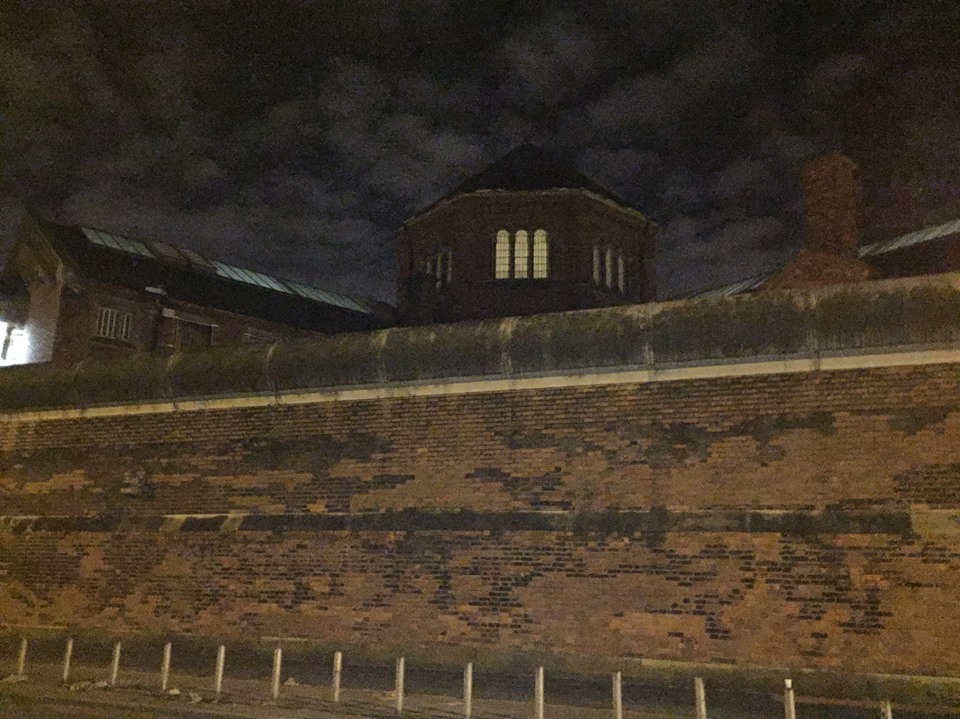David Scott, Open University

[HMP Manchester. Photo source: David Scott]
On the 3rd November 2016 the government published Prison Safety and Reform, its vision of the future of the Prison Service in England and Wales. Claimed to be the “the biggest overhaul of prisons in a generation”, at the start of her foreword, Justice Secretary Liz Truss approvingly cites the words of nineteenth penal reformer Elizabeth Fry:
The better the actual state of our prisons is known and understood, the more clearly will all men [sic] see the necessity of these arrangements by which they may be rendered schools of industry and virtue.
Liz Truss clearly places great weight on “evidence” and “data”, yet the portrayal of the ‘actual state of our prisons’ in the media in the days preceding and following the white paper (including The Guardian editorial on the 3rd November) has mystified and mislead rather than generated knowledge or understanding.

[Elizabeth Fry. Source: anglotopia.net]
Prisoner violence and rehabilitation
One of the key goals of Prison Safety and Reform is to remove obstacles preventing the rehabilitation of prisoners. The reason given for the failure of prisons to rehabilitate is prisoner violence. The white paper notes that since 2012 there have been significant rises in recorded incidents of prisoner violence and that in 2016 there are 65 assaults in prisons every day. As “reform can only take hold in a safe and disciplined prison environment” it is essential, the white paper informs us, to dramatically reduce prisoner violence so we can achieve “a more stable estate, in which staff and prisoners have the time and headspace to address the causes of re-offending”. Whilst Prison Safety and Reform provides a number of alleged reasons for the increases in violence, the one placed most prominently in public spotlight is the decline in numbers of prison officers.
The day before the publication of Prison Safety and Reform, Steve Gillan, General Secretary of the Prison Office Association [POA], received enormous publicity when he claimed that as a consequence of a 25% reduction in the number of prison officers in the last six years, prisons were now places of “carnage and bloodbaths”. His claims were evidenced with a mixed set of data pointing to the high levels of recorded prisoner violence, self-inflicted deaths and recorded assaults on prison officers. These apparently intimate connections have been taken as ‘common sense’, by politicians and media commentators alike. No-one in the media has highlighted the limitations of the statistical evidence presented in the white paper or by the POA. Yet a number of their assumptions do not stand up to scrutiny. Let us consider three:
(1) decline in prison officer staffing levels;
(2) the rise in recorded assaults on prison officers;
(3) staffing levels and self-inflicted deaths of prisoners.
Our dedicated and brave staff
Prison Safety and Reform draws upon statistics showing:
The number of Band 2 to 5 frontline operational staff reduced from 29,660 on 31 March 2012 to 23,080 on 31 March 2016. As violence has increased it has become harder to retain existing staff, thus creating a vicious cycle of staff pressure and violence.
The white paper states that recent reductions in prison staff levels have led to increased prisoner violence and placed intolerable “operational strains on the dedicated and brave staff that work in our prisons”. Consequently there is to be an immediate increase in prison officer numbers (in total 2,500) and new reforms aiming to facilitate prison officers who are not just “security guards and minders but also mentors” with a dedicated case load of six prisoners. In so doing “frontline staff will be given the time and the tools they need to supervise and support offenders so they can turn our prisons into places of safety and reform”.
When studying numbers of prison officers through an historical lens we can see they have risen in recent decades to their highest ever levels. The real problem is that the prisoner population has doubled from around 40,000 in 1990 to nearly 85,000 in 2016. Prisons have never had high numbers of paid staff. In the eighteenth century some prisons only had 1 paid turnkey (prison officer) for every 100 prisons. Even by the mid-nineteenth century the vast majority of prisons still had less than 10 staff, largely because prisons at this time were run by ‘prisoner warders’, who undertook nearly all of the key functions of the prisons, including locking and unlocking other prisoners.
From the 1870s with the professionalisation of paid prison staff, official data on frontline staff- prisoner ratios began to stabilise at around 1 member of staff for every 6 prisoners. Yet evidence from prison officers, such as H.U. Triston in the 1930s, indicate that at the start of the twentieth century the ratio was more like 1 prison officer to between 20-50 prisoners. From the 1950s the official staff-prisoner ratio fell for four consecutive decades, so that by 1990 the prison officer-prisoner ratio was 1 prison officer to every 2.3 prisoners. Because prisoner populations doubled, the prison officer-prisoner ratio increased to 2.8 prisoners by 2010 in public sector prisons. Following the recent staff cuts, by March 2016 the ratio had increased to 1 prison officer to every 3.6 prisoners, which brought public sector staff ratios largely in line with private sector prisons. If the proposed new 2,500 officers are factored in, the ratio of prison officers will fall to 3.3 prisoners in public sector prisons.

[HMP Birmingham, 2011. Source: Newsrt.co.uk]
But things are not quite as simple as the sound. This data only tells us so much. Important considerations missing include the amount of hours officers work in the prison in a given week, the quality interactions between prison officers and prisoners, and the security classification of a particular prison. Over the twentieth century the amount hours worked in prisons by prison officers reduced dramatically, falling from as high as 72 hours a week to as low as 39 hours and since the late 1960s prisoners have been separated across the penal estate based on security risk. Prison officer-prisoner ratios have been as low as 1 prison officer to every 1 prisoner in dispersal / high security prisons but as high as 1 prison officer for every 8 prisoners in lower security prisons. Significantly, and despite a new emphasis on prison officers performing a rehabilitative role from the 1920s onwards, no comparative decrease in prisoner reoffending rates can be mapped onto changes in staff-prisoner ratios.
Punch bags and crying wolf
In the recent media coverage of prison reform POA General Secretary Steve Gillan highlighted the remarkable increase in the number of recorded assaults against prison officers. He noted the POA “will not stand by and watch our members become punch bags on a daily basis”. These sentiments are reproduced in the white paper Prison Safety and Reform.
Prison safety has declined since 2012. Levels of total assaults across the prison estate and assaults on staff are the highest on record, and are continuing to rise. Comparing the 12 months to June 2016 with the calendar year 2012:
- total assaults in prisons increased by 64%;
- assaults on staff rose by 99%;
- the number of self-harm incidents increased by 57%
The white paper calls for “a robust and swift response” to the rise in assaults. It also highlighted that killing a prison officer would result in a life sentence. Yet any talk about violence against prison officers and their likelihood of being murdered by a prisoner should be considered in historical context. Since 1850 only eight members of staff (and not all of these prison officers) have been killed in prisons in England and Wales. The last prison officer to be murdered at work was Derek Lambert, who was killed at Portland borstal by a prisoner in 1965. It was the first murder of a prison officer for some 30 years in England and Wales and proved to be an isolated incident. Not only is serious physical violence against officer by prisoners rare, but there are also many examples of prisoners going to their aid in dangerous situations, such as during prison disturbances.
On the 6th November, following disturbances at HMP Bedford, the POA were once again reasserting claims regarding prison staff numbers and prisoner violence. The media accepted their claims without question. During the HMP Bedford disturbance no prison officers were injured, but almost immediately the POA made claims to the BBC and The Guardian that the disturbance was directly linked to the lack of frontline staff and provided further evidence that prisoners are starting to take control of prisons. In so doing the POA ignored the fact that the largest prison disturbance in UK history in April 1990, which involved 25 different prisons, occurred at a time when staff-prison ratios were at an all-time historical low. Prison disturbances are generated by people living in inhuman and degrading living conditions, denial of voice, prison officer brutality and being treated like animals. They certainly cannot be reduced to staffing levels alone.

[Prison Officers Association. Source: http://www.poauk.org.uk]
The current focus of the media and white paper on prisoner violence and assaults on prison officers has only utilised data from the last 4 to 6 years. In the period from 2000-2009, however, there was also a 61% increase in prisoner violence. This rise was not at the time tied together with prisoner deaths or data about reported assaults on prison officers, the latter of which were actually declining. The POA noted in 2011 that on average, one prison officer each week required hospital treatment following an assault by prisoners, indicating that there were 52 serious assaults a year on prison officers. Concerned in particular about the failure of the Crown Prosecution Service to prosecute prisoners (a punitive approach rather than one focused on safety), on the 17th April 2012 POA General Secretary, Steve Gillan, called on all prison officers to “always report assaults”. Crucially, the data on assaults on prison officers cited in the white paper Prison Safety and Reform is detailed only from 2012 onwards.

[Steve Gillan, Prison Officer Association. Source: tuc.org.uk]
What the POA has not called for is for prisoners to always report assaults by prison officers. That prison staff violence continues to be a problem was evidenced earlier this year at Medway Secure Training Centre when BBC Panorama, 11th January 2016 caught staff brutalising and assaulting child prisoners on camera.
Carnage and bloodbaths
Ironically, there is evidence indicating that prisons really can be deadly for prison officers. This data, however, refers to the life expectancy of prison officers following retirement. At only 18 months this is one of the shortest life expectancy rates of all occupations. The toxic and deadly fumes that prison creates are not just restricted to prison officers, but to those whose voice is generally not heard in the white paper Prison Safety and Reform: prisoners.
Prison Safety and Reform reveals that there were 107 self-inflicted deaths [SIDs] in prisons in the 12 months to September 2016. Whilst data on prisoner SIDS over the last four years appears to support the claims of Prison Safety and Reform, when placed in historical context the connection between prisoner deaths and prison staffing levels is much less clear. Research by Professor Joe Sim has uncovered detailed historical evidence indicating that prisons have always been places characterised by violence and death. Whilst historical data is inconsistent, and there are significant difficulties with making comparisons regarding terminological differences between SID’s and suicides, the data indicates there is no obvious correlation between a decline in rates of self-inflicted deaths and rises in prison staffing levels. Officially recorded SIDs in the last four decades have risen substantially. In 1986 there were 21 recorded suicides in prison but in 1998, for the first time, more than 80 people to their own lives. Even high levels of SIDs pertained in the 1990s and early 2000s, predating data cited in Prison Safety and Reform by a number of years. Thus, when looking at trends over the last four decades we actually find record high rates of recorded self-inflicted deaths at the same time as record low levels of prison officer – prisoner ratios.
The evidence cited above should be read carefully and with great caution, but given the strong commitment of Liz Truss to deliver ‘evidence led penal policy’ recognition of the narrow focus and restrictive timeframe placed around statistical evidence in the white paper is undoubtedly important. As is media scrutiny, for the currently uncontested POA data presents an account of current prison realities that inevitably directs us towards a specific set of solutions: more prison officers and more prisons. Such an uncritical adoption in the media of the POA informed explanatory framework not only closes down opportunities for a more informed debate in a time when we have record numbers of prisoners, but it also rules out alternative policy solutions, such as those that would reduce the number of prisoners and close our degrading and inhuman prisons rather than build new ones.
 An image of a homeless person sleeping in a park in Canada. Source: https://www.123rf.com/photo_31129604_14-may-2014-montreal-canada-homeless-person-sleeping-at-downtown-park-during-the-day-the-financial-c.html
An image of a homeless person sleeping in a park in Canada. Source: https://www.123rf.com/photo_31129604_14-may-2014-montreal-canada-homeless-person-sleeping-at-downtown-park-during-the-day-the-financial-c.html















